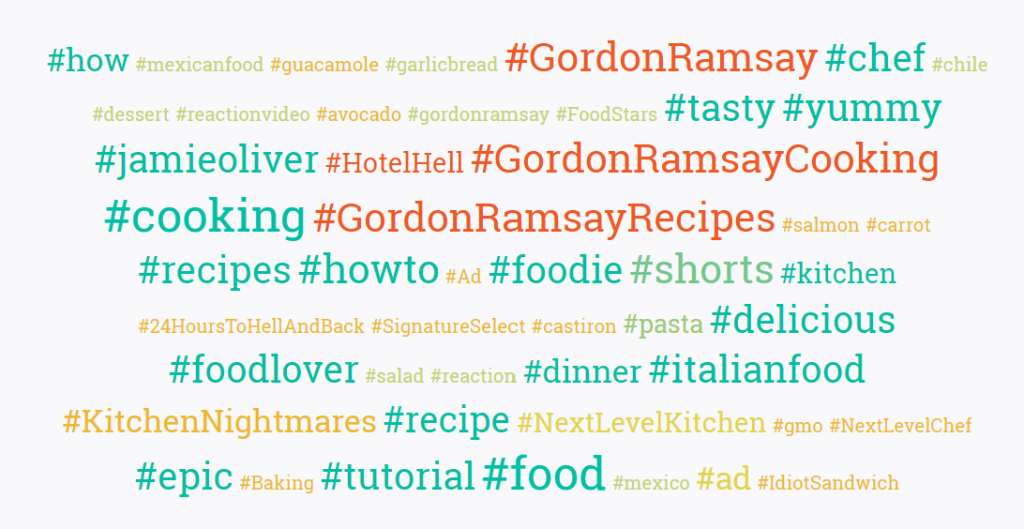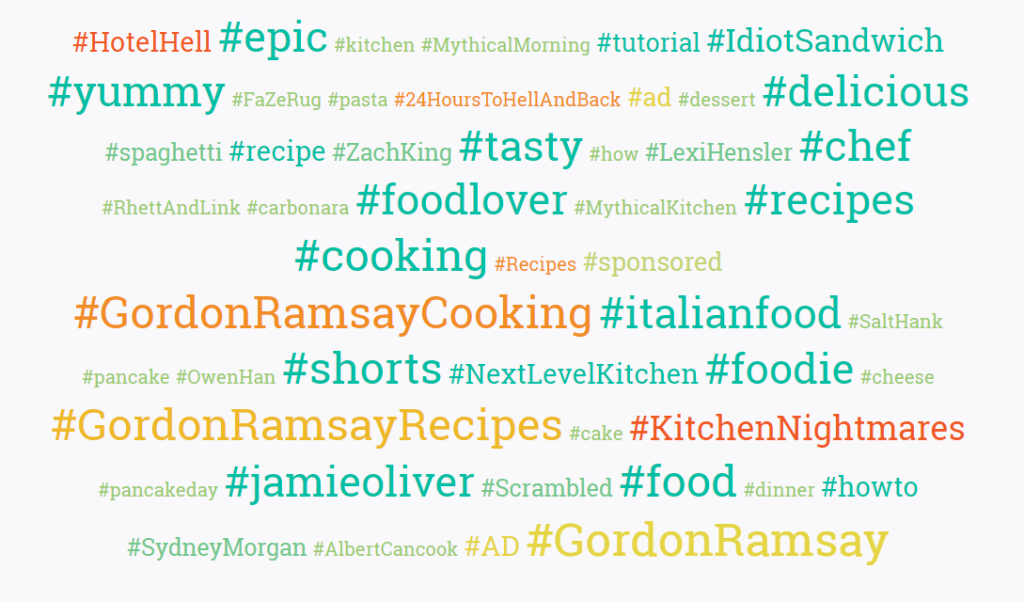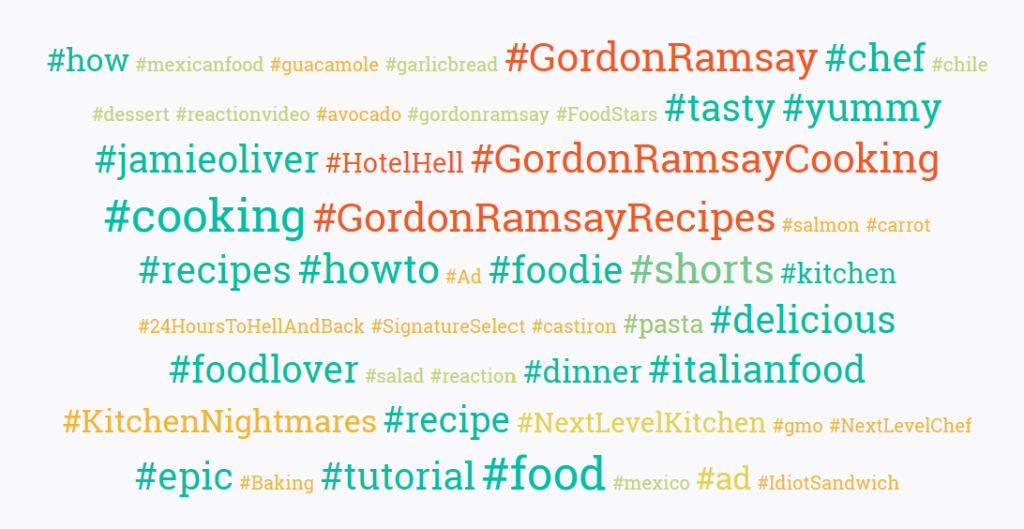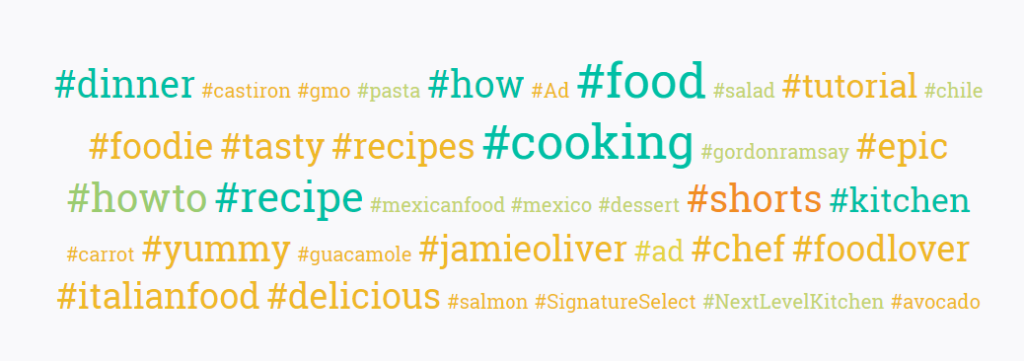Finding the Best YouTube Hashtags

YouTube is the place that many go to learn about a topic, to find out how to do a task, or just to be entertained. The demand for content on YouTube has allowed many people to make a successful living making videos for this very social media network. However, with so much content out there, how can you get your content and channel noticed?
There are already many good articles that discuss various topics related to growing your channel, whether it relates to increasing views or improving your engagement rates. However, in this article, we want to take a more focused look at a topic that many may not immediately think of when researching how to improve your YouTube channel’s performance: hashtags.
Using the right hashtags for YouTube is an important factor in the overall success of your content and your channel overall. But how do you go about finding the YouTube hashtags that are both relevant to your channel and will help your performance?
The answer is by conducting hashtag research for YouTube that is based on data not only from your own channel, but also other similar channels. With this in mind, we will show you how to do YouTube hashtag research in order to find the best hashtags for your YouTube channel. In doing so, we will explain what you need to conduct YouTube hashtag research effectively, how to understand the data you collect, and how to measure your success.
Why Not Simply Research Trending Hashtags for YouTube?
Before getting into the topic of how you can conduct YouTube hashtag research, let’s start discussing a related question: why not simply research YouTube’s trending hashtags? After all, doesn’t it make sense to find out trending YouTube hashtags so you can jump on these topics no matter what they are?
While knowing what YouTube hashtags are trending at a given movement may be interesting, there are actually two fundamental problems with this approach. The first has to do with relevance. It is important to make sure that your hashtags are relevant for the content you are producing. Using irrelevant hashtags will hurt the overall performance of your videos, since people may come to your content after searching for a specific hashtag and then immediate bounce once they realize that your video has not relation to the hashtag you used.
The second issue relates to finding what hashtags may be able to help you increase your overall interaction rates. Simply looking at trending hashtags doesn’t tell you the whole story with regard to what hashtags actually correspond to a high number of interactions. At the end of the day, it is important for your videos to receive likes, comments, shares, etc. This is because one of the ranking factors of the YouTube algorithm relates to engagement rates of videos.
As we will cover in the remaining parts of this article, the best hashtags for YouTube should be focused on your channel and topic, as well as take into account what hashtags correlate with high post interaction rates. While hashtags by no means will make poor content successful, finding the best hashtags for your YouTube videos can be one of the ways that you can get an edge over your competition.
Finding the Best Hashtags for your YouTube Content
So now that we know that simply identifying various trending YouTube hashtags is not the whole story, let’s discuss how you can conduct hashtag research for YouTube. As we already pointed out, you want to find hashtags that are relevant for your content niche or industry, as well as those that correlate with high post interaction rates or some other type of key metric you care about.
One of the advantages of using a social media tool that allows you to track an unlimited number of profiles is that you can bring in many different YouTube channels to your analysis to give you a better idea of what hashtags are performing best in your industry. Creating meaningful data sets is important for accuracy and so that you can feel confident that your results are leading you in the right direction.
In order to help you better understand how to conduct YouTube hashtag research, we want to go through the steps you need to take with a real-world example. As many of you probably already know, several celebrity chefs have huge followings on social media as well as television. So, if you were building your own channel in this content niche, what type of hashtags should you use?
To answer this question, we will conduct YouTube hashtag research to find out what types of hashtags we should if we have a channel related to cooking be using by analyzing the data from the following profiles: Bon Appétit, Gordon Ramsay, Jamie Oliver, Joshua Weissman, NYT Cooking, Pro Home Cooks, Tasty, and You Suck At Cooking.
Below, we will go into detail of the 5 steps that you can follow in order to set up your analysis properly as well as to implement you findings.

Step 1: Select your Profiles to Analyze
As we pointed out already, simply researching what YouTube hashtags are trending at a given moment is probably not the data-drive approach you want to take. However, if we want to take a data-drive approach with a large enough data set, what do we need to do? The answer is by adding similar profiles to your analysis so you can understand what hashtags for YouTube videos in a particular niche perform best.
But what do we mean by similar profiles and why is identifying similar profiles so important. Similar profiles are those channels that post content that is about the same topics that your channel posts, as well as have the same target audiences. Similar profiles are generally also posting in the same language that you post in.
The importance of adding similar profiles to yours is to make sure that the hashtags that you analyze will be related to the content are you posting. The more similar profiles you can find the better since there are more data points to use in your analysis. Along these lines, the biggest advantage of using the right social media tool that allows you to track unlimited profiles is that you can bring in dozens or more relevant channel profiles to your analysis. This allows you to better find the best hashtags for your YouTube videos that are both being used by your target audience as well as the ones correlated with the highest post interaction rates.
There are no hard and fast rules for selecting similar profiles other than making sure they are focusing on the same content areas and have the same target audiences. You most likely already know many of the voices in your content niche and, therefore, know what profiles you want to add to your analysis. However, it may be helpful to also further research profiles that you can add to your study in order to have more data points to analyze.
Step 2: Determine the Time Period for your Data Set
You may think that best hashtags for your YouTube channel stay the same year round. In reality, this may not be the case. Hashtags may be seasonal, and the content topics that they represent may be more popular in specific months or times of the year. For instance, for cooking there may be special summer cooking topics that different from winter cooking topics. These can be reflected in the hashtags that people are searching for.
The time period for your analysis affects the number of data points you will have in your study. If you choose to analyze historical data for an entire year, for instance 2023, then you may have a lot of data point, but you may not detect granular month-to-month changes in the hashtags that were being used. Focusing on a single month, for instance July 2023, may give you a more precise look into the top-performing hashtags for this time, but you may not have as many data points. So, how do you select the timeframe you want to analyze with regard to finding the best hashtags for your YouTube channel?
It is important to note that you know your industry and are best able to determine if there are changes month to month or in various seasons. If there are, then it probably makes sense to focus first and foremost on specific months or seasons for your analysis. However, if you have reason to believe that hashtags are not affected by specified seasons, then you may want to concentrate on longer timeframes.
Keep in mind that you can conduct different studies of the profiles you are tracking that look at both long-term time periods as well as specific months. This is one of the main advantages of using a social media tool that excels in hashtags research, namely that you can conduct different types of analysis (more on this shortly). However, make sure your social media tool can allow you to select different dates and that you have access to this historical data.
Step 3: Specify your Data Output and Study your Results
Simply setting up a study and running analyses of hashtags is only the first part of the process related to YouTube hashtag research. You also need to determine what you want you gain from running a YouTube hashtag analysis. Below, we will go through some different ways you can look at your data depending on what you want to accomplish. As we already pointed out above, we will be analyzing the 8 aforementioned YouTube channels relating to cooking. Please note that all of the graphs and charts below are generated by the Fanpage Karma all-in-one social media tool.
Let’s begin with analyzing the various hashtags used by the profiles mentioned above in a metric table. You may want to be able to look at every hashtag used in a specific timeframe and be able to sort them by a particular metric such as post interaction rate, interactions per impression, or simply the total number of comments. A metric table allows you to see all these hashtags, the metrics associated with each hashtag, and allow you to filter them according to specific metrics. The image you see below comes from an analysis of these YouTube channels from April 2024.

However, perhaps you are not so concerned with scrolling through a long list of hashtags and instead what to simply look at the top performing according to a specific metric. Below are some different ways you can view the same data from April 2024. The first is a bar chart that shows the hashtags with the highest post interaction rates in this time period.

However, you are not restricted to only looking at post interaction rates, but you can choose from other metrics as well. For instance, you may want to find the best YouTube hashtags for views by looking at the total number of views per video for a specific time period (in this case also from April 2024).

Another way you can study hashtags is through a word chart. The word chart below, which also analyzes the hashtags for the selected profiles in April 2024, shows hashtags of different sizes (indicating how often they were used) as well as in different colors (with greener hashtags corresponding to higher post interaction rates). The advantage of the word chart is that you see popular hashtags for these YouTube channels, as show by the size of the word, while also seeing which ones generate the most interactions, which is reflected in the color of the word.

You may also want to research trending YouTube hashtags that have strong post interaction rates for a longer timeframe. Below is a word chart analysis for January-March 2024. You can see how this differs from the chart above which focuses only on April 2024.

In all, the search for the best hashtags for your YouTube channel will depend on what your goals are and what metrics you are interested in. As you see from the different charts and graphs above, you can run different analyses to look at the data in different ways. For many, it may make sense to look at a variety of graphs and metrics so you can get different looks at the data.
Researching Content Formats: The Best Hashtags for YouTube Shorts
You might be wondering if there are differences between different content formats when it comes to hashtag research. For instance, you may be researching hashtags for YouTube Shorts specifically. If you want to research YouTube Shorts hashtags, you certainly can do so with just a few adjustments. As you see in the image on the right, you simply need to specify the content format that you are interested in.

We want to stress here that selecting for a specific content format, in this for case Shorts, can change your data output. For instance, trending hashtags for YouTube Shorts in a particular industry may be different than if you analyze all content formats (this applies for other social media networks as well). Below, you can see the word chart for all content formats from April 2024 that we already presented above.

However, you can them make an adjustment (as shown above) to find out more about the trending Youtube Shorts hashtags or these channels in our study. You can then study the word chart only for YouTube short, in this case from April 2024.

Of course, you may want to find YouTube shorts hashtags for views or other metrics, which you would then make adjustments for in your social media tool. Ultimately, the best hashtags for your YouTube shorts will be determined by the types of metrics you are interested in and what your data is telling you.
Step 4: Use The Best (and most relevant) Hashtags in your Posts
Hashtag research for YouTube is important, but is not the whole story here. It may sound obvious, but you actually need to implement your findings. Along these lines, it is essential that you make sure that you organize your hashtags according to topic and then actually use them once you publish your videos. When you organize the best performing hashtags according to topic, you can more easily find relevant hashtags for the various topics you are addressing in your videos.
Step 5: Monitor your Progress and Continue Researching
There are two essential activities you should focus on after you have run your first hashtag analysis: monitoring your results and continuing to research hashtags. First, it is important to monitor your progress related to your social media performance. While hashtags will not automatically improve your performance, you can monitor various metrics associated with your posts to see if you are making progress. With the right social media tool, you can even benchmark your progress compared to many of your competitors, which can be helpful in seeing if other changes in your strategy need to be made.
In terms of continuing your YouTube hashtag research, it is crucial to understand that trends change and so do the hashtags people search for. While conducting hashtag research for the first time is a great place to start in terms of optimizing your YouTube channel, there is a need to stay on top of trends. This is what makes finding the right hashtag research tool so important.

Conclusion: How to Find the Best YouTube Hashtags
Ultimately, finding the best hashtags for YouTube will depend on your target audience, industry, and/or market. That is why we have emphasized the need to conduct your our own YouTube hashtag research in order to find the best hashtags for your channel and content. Keep in mind that the more relevant profiles that you add to your analysis, the more accurate data set you can work from.
The most important point we want to highlight is that the process of finding the best hashtags for YouTube is in your hands. By understanding your industry or content niche and adding the right profiles to your data set, you can effectively find what hashtags you should consider using for your own videos. In other words, don’t rely solely on intuition or what is trending, but rather take a data-driven approach to finding YouTube hashtags to use.
If you are looking for a tool that allows you to conduct YouTube hashtag research, then you can try Fanpage Karma’s free 14-day trial and see for yourself how this tool can help you. In addition to powerful hashtag analysis functions, it also offers analytics and benchmarking, publishing, research, and community management features.
You are also welcome to participate in the free weekly webinar that Fanpage Karma offers that shows you how to use the tool to improve your social media performance.









